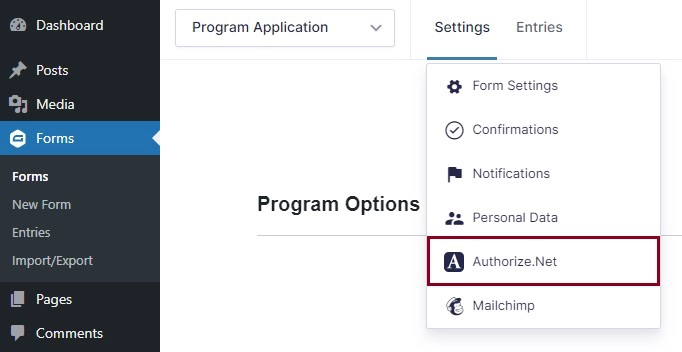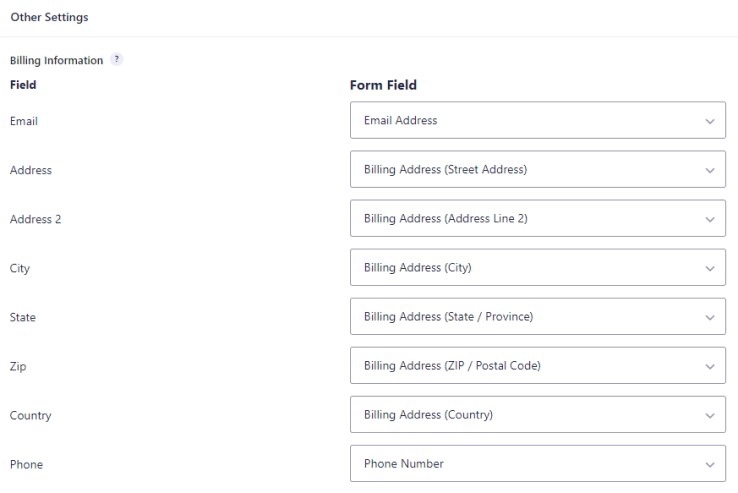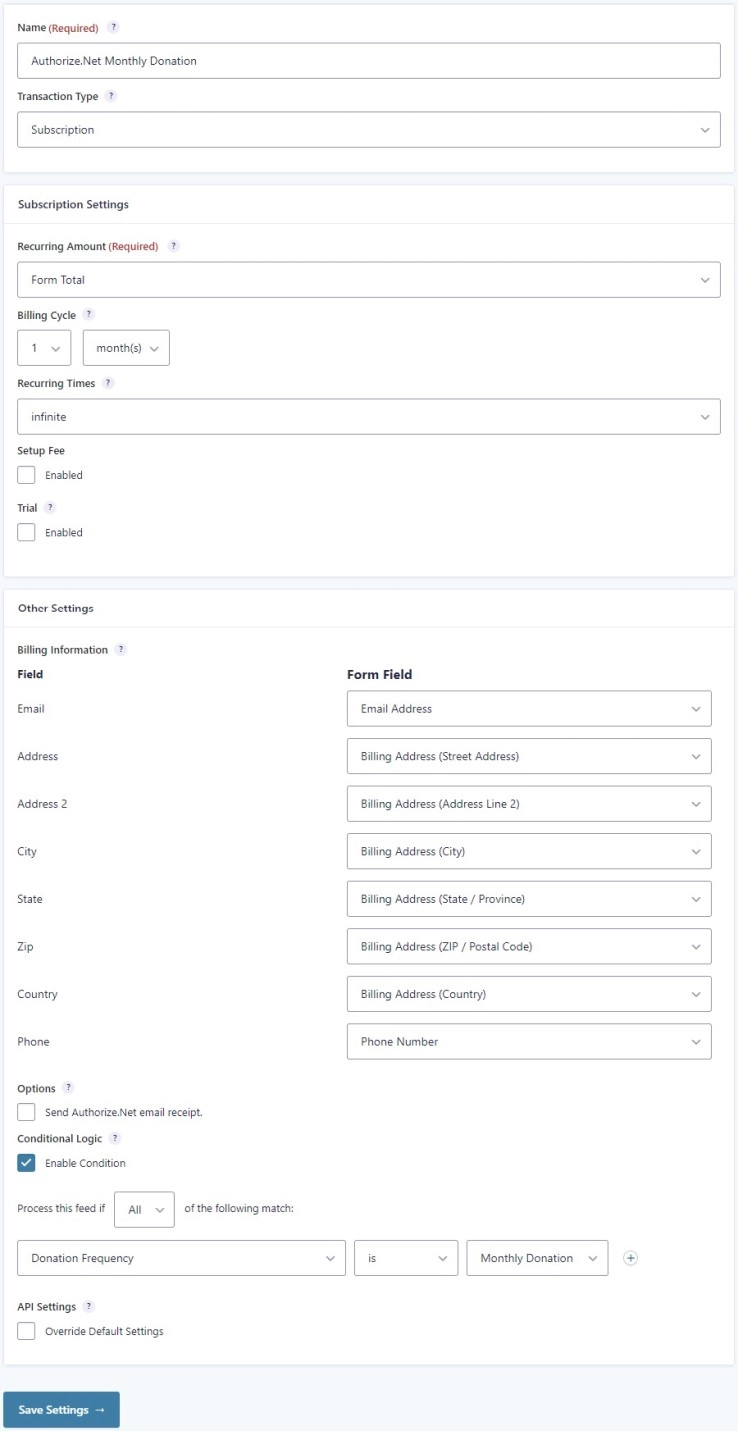Use the steps below to connect your paid form with Authorize.Net to charge visitors when they submit. Before hopping in, please review the helpful terminology below related to this process.
FEATURE AVAILABILITY
The Form Builder is available for Grow and Amplify plan websites. Change your plan in the Account & Billing section of your website Dashboard.
Helpful Terminology
- The payment processor is the service you use to charge people money online. This provider manages transactions and ensures that the funds end up in your account. The most common providers are Stripe, Authorize.Net and PayPal.
- A feed on a form refers to that form’s connection with a third-party provider. For example, you might set up a feed to charge a visitor through PayPal for the amount they offered to donate. This feed is typically processed each time a visitor submits your form.
- Conditional logic is used to determine the criteria in which a form’s feed is processed. For example, you may have two feeds on a donation form: one that processes a single donation and another that processes a recurring monthly donation. For the feed processing recurring payments, you would set up conditional logic to only process the feed when the donor selects the option to make a monthly gift.
- The “Product” field type used in your form determines what the visitor is paying for and how much a visitor should be charged when they submit. A Product field can have a fixed price, such as for a t-shirt, or it can be a variable price that the visitor sets, such as a donation amount.
- The “Sales” tab provides a convenient way to view specific results and will only appear for forms that accept payments, making tracking and managing payments easier.
If your organization uses a payment processor that isn’t Authorize.Net, learn how to connect to other services.
Setting Up an Authorize.Net Feed
- While editing your paid form, hover over the Settings menu and click Authorize.Net in the dropdown.

- Click the Add New button to create a new feed.
- Enter a Name for the feed. You can set this name to something generic such as “Authorize.Net Feed”, or if you end up having multiple feeds that only run under specific circumstances, we’d recommend naming it something more descriptive.
- For example, on a donate form you may end up with two feeds, one to process one-time donations and another to process recurring donations. In that case, we’d recommend naming the feeds “One-Time Donation” and “Monthly Donation” to make sure they’re clear.
- Choose the Transaction Type. If you plan to charge the visitor one time, choose Products and Services from the dropdown. If you plan to charge them on a regular basis, such as monthly or yearly, choose Subscription from the dropdown.
Settings for Products and Services
If you chose Products and Services from the Transaction Type dropdown, be sure to adjust the following settings.
- Choose the Payment Amount you want to charge the visitor. We recommend you almost always choose Form Total. This will combine the price of all selected products to charge the visitor.
Settings for Subscriptions
If you chose Subscription from the Transaction Type dropdown, be sure to adjust the following settings.
- Choose the Recurring Amount you want to charge the visitor. We recommend you almost always choose Form Total. This will combine the price of all selected products to charge the visitor.
- Select the correct Billing Cycle to determine how often the visitor needs to be charged. For example, to charge the visitor every six months set the fields to read “6 month(s)”.
- Modify the Recurring Times field to determine how many times the recurring payment should be made. This should almost always be set to “infinite” but can be modified as needed.
- You can check the box to enable a Setup Fee to be charged once, not on a recurring basis. Once that box is checked, choose which of the form’s products includes the amount to charge. This feature is rarely necessary for a form.
- You can enable a Trial that will charge the visitor the amount of the product you select for one billing period. For example, if the Billing Cycle you chose was “6 month(s)” the visitor would be charged the trial amount for the first payment, then the full amount of the subscription six months later. This feature is rarely necessary for a form.
About Billing Information & Receipts
- For the Billing Information, select the fields on your form under the Form Field section to map them with the corresponding Field on the left. Try to map as many of your form fields as possible. If you’re missing one, such as Phone, you can leave it set to “Select a Field”.
- Be careful to map the fields correctly. In some cases, forms will have two fields with very similar names. For example, a field called “Address” and one called “Billing Address”. Make sure you select the correct one. When you’re done, the information should look similar to this screenshot.

- Check the box to Send Authorize.Net email receipt if you’d like Authorize.Net to send a receipt via email on your behalf. We recommend leaving this unchecked and instead sending a thank you email notification from your form since it can be customized much more than an automated receipt.
About Conditional Logic
Both types of transactions allow for conditional logic. If you’d like the feed to execute only under certain circumstances, check the box to enable Conditional Logic. The conditional logic shown below causes the feed to execute only when the visitor chooses “Monthly Donation” for the Donation Frequency field.

Please note that you can modify the feed to add multiple conditions using the plus (+) icon on the far right and can also choose to execute the feed if “All” or “Any” of the conditions are true.
Finish Your Feed
- You can leave the API Settings unchecked since it’s only needed if you plan to process transactions from your form through an entirely different Authorize.Net account than the one your website is connected to.
- Review your settings and click the blue Save Settings button to save your feed.
- If you need to add another feed to the same form, start over and follow these steps again until all the necessary feeds are created. For example, when creating a donation form, you’ll usually need two feeds, a feed that executes and charges for only one-time donations, and another to charge only for recurring donations.
- Most importantly, please test your form including each feed to ensure they process payments as expected.
A Complete Authorize.Net Feed Example
For reference, we’ve included a screenshot below of a completed Authorize.Net feed. This feed processes only monthly donations on a typical donation form.

Still Have Questions?
The quickest way to get support is to reach out to us within your website’s admin dashboard. Log into your website and then fill out the Request Help form. You’ll hear back from us within one business day.